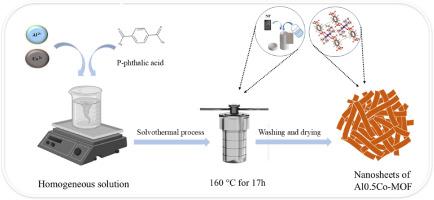Enhanced electrochemical performance and structural stability of Co-MOF via Al doping for high-performance supercapacitors
IF 4.9
3区 材料科学
Q2 CHEMISTRY, MULTIDISCIPLINARY
引用次数: 0
Abstract
Metal-organic frameworks (MOFs) are attractive candidates for energy storage devices owing to their significant surface areas, tunable porosity, and numerous applications. However, monometallic MOFs have several limitations, such as restricting the variety of chemical interactions, low chemical stability, and electrical conductivity. This study utilizes Al-doping to modify the structure of pristine Co-MOFs to address the constraints of monometallic Co-MOFs. In particular, the morphology and electrical conductivity of the resulting electrode (Al0.5Co-MOF) were altered by the addition of a certain amount of Al to the Co-MOF. An impressive specific capacitance of 2684.64 F g−1 was generated by this structural alteration at a current density of 1 A g−1. The Al0.5Co-MOF//AC demonstrated an impressive energy density of 57.03 Wh kg−1 with a power density of 824.769 W kg−1. In addition, the Al0.5Co-MOF//AC exhibited exceptional cycle stability retention of 94 % after 10,000 charging and discharging cycles.

Al掺杂提高了高性能超级电容器Co-MOF的电化学性能和结构稳定性
金属有机框架(mof)由于其显著的表面积、可调的孔隙率和众多的应用而成为储能器件的有吸引力的候选者。然而,单金属mof有一些局限性,例如限制了化学相互作用的多样性,化学稳定性低,电导率低。本研究利用al掺杂来修饰原始Co-MOFs的结构,以解决单金属Co-MOFs的限制。特别是,通过在Co-MOF中加入一定量的Al,所得到的电极(Al0.5Co-MOF)的形貌和电导率发生了变化。在1 a g−1的电流密度下,这种结构改变产生了令人印象深刻的2684.64 F g−1的比电容。Al0.5Co-MOF//AC的能量密度为57.03 Wh kg−1,功率密度为824.769 W kg−1。此外,在10,000次充放电循环后,Al0.5Co-MOF//AC的循环稳定性保持率为94%。
本文章由计算机程序翻译,如有差异,请以英文原文为准。
求助全文
约1分钟内获得全文
求助全文
来源期刊
CiteScore
7.80
自引率
2.50%
发文量
605
审稿时长
40 days
期刊介绍:
The Journal of Physics and Chemistry of Solids is a well-established international medium for publication of archival research in condensed matter and materials sciences. Areas of interest broadly include experimental and theoretical research on electronic, magnetic, spectroscopic and structural properties as well as the statistical mechanics and thermodynamics of materials. The focus is on gaining physical and chemical insight into the properties and potential applications of condensed matter systems.
Within the broad scope of the journal, beyond regular contributions, the editors have identified submissions in the following areas of physics and chemistry of solids to be of special current interest to the journal:
Low-dimensional systems
Exotic states of quantum electron matter including topological phases
Energy conversion and storage
Interfaces, nanoparticles and catalysts.

 求助内容:
求助内容: 应助结果提醒方式:
应助结果提醒方式:


